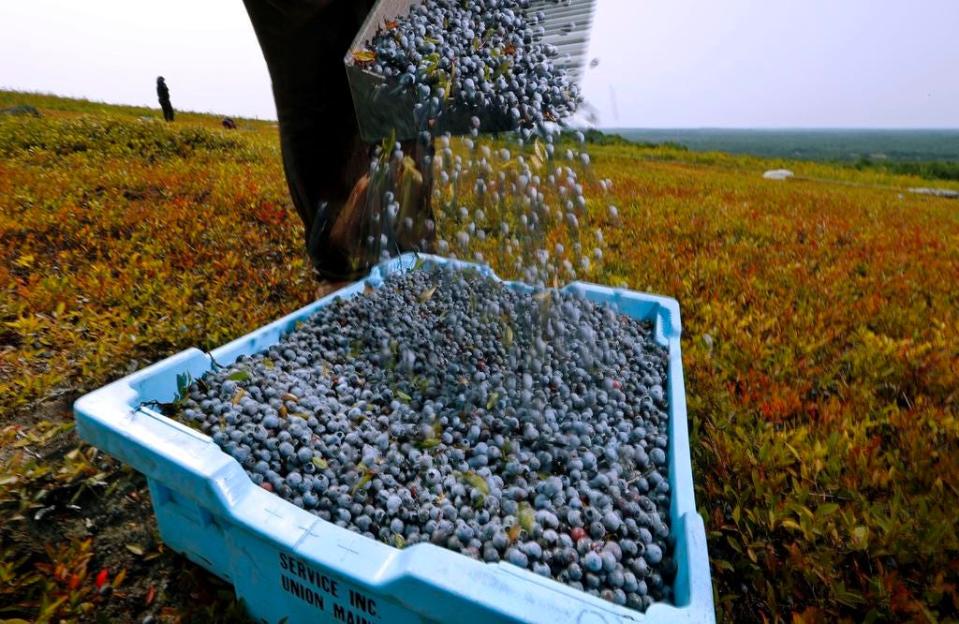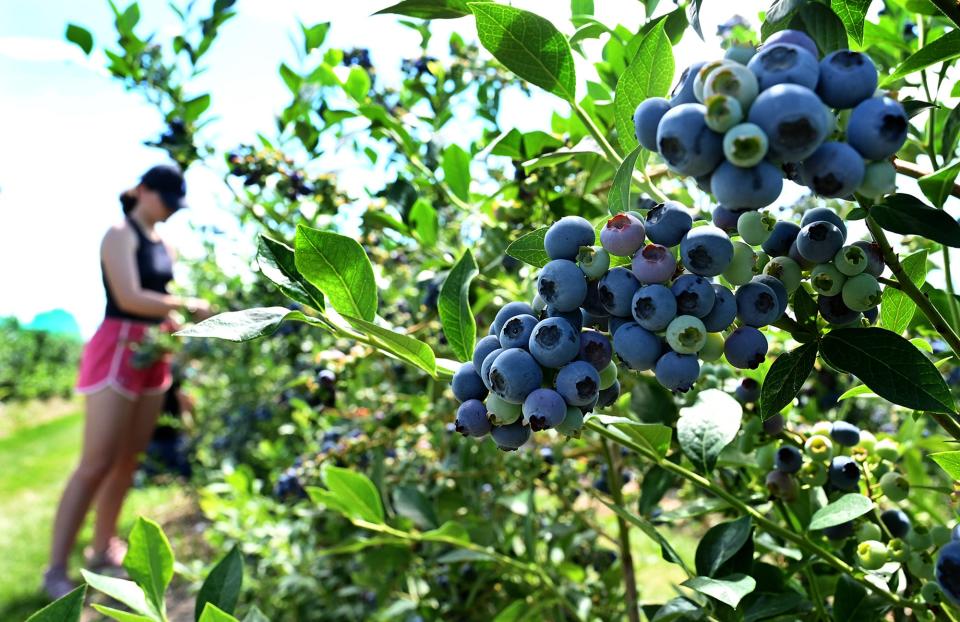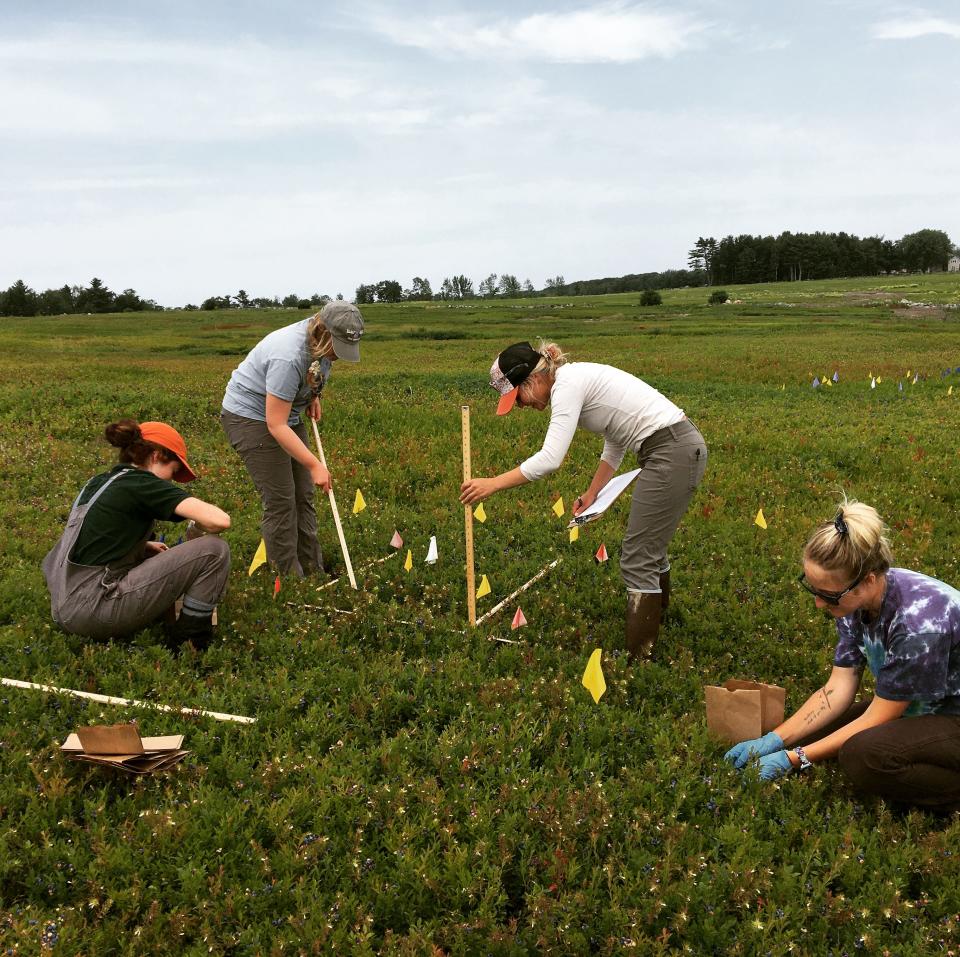Blueberry season comes to a close. How the summer drought impacted New England growers.
The wild blueberries were smaller this summer in the barrens of Maine, where the sweet crop expanse dominates treeless plains of sandy soil.
Some of the lowbush berries started shriveling or ripened too quickly, hitting the dry ground before harvest season began. The drought-stressed plants were speeding up their production process.
Lobster and blueberries go hand-in-hand when people think of Maine. The state's iconic wild blueberries are one of only three fruits native to North America, and they're loaded with twice the antioxidants than their ordinary crop equivalent. There are 36,000 acres of commercial wild blueberry land in the state, and the crop's total value reaches tens of millions of dollars each year.
But climate change-induced drought is threatening the superfood fruit, particularly the native lowbush species in Maine where irrigation systems are few and far between.
Meanwhile, in other parts of New England where farmers grow highbush blueberries, the crop proved more adaptable this summer — with help from irrigation.

With climate change creating a world of extremes in New England — longer and more frequent dry spells punctuated by deluges of rain within shorter periods of time — the region's blueberry farmers face the task of adapting.
What we've learned: How a summer of extreme weather reveals a stunning shift in the way rain falls in America
Calling all leaf peepers: Drought to impact this year's fall foliage in New England.
"In every season, there are all of these different weather events that can happen that can increase or decrease the crop," said Lily Calderwood, extension wild blueberry specialist and assistant professor of horticulture at the University of Maine. "Every year is a new adventure. And because of climate change, we have seasonal droughts that occur more frequently now."

Some New England blueberry growers more impacted by drought than others
It was a "hard year" for blueberries in Maine, said Calderwood, but the drought impacts were not felt equally among all of New England's growers this summer.
In Massachusetts and Rhode Island, where drought conditions raged and reached "severe" designations in some parts, growers reported a good harvest season that's typically late July through August.
Ticks, mosquitoes: How climate change will bring more pests and disease to New England
Calderwood explained the major difference is lowbush versus highbush blueberries. Growers in southeastern New England harvest highbush blueberries, the species typically found in grocery stories. Highbush blueberries have always been irrigated because they are grown in rows, said Calderwood, while wild blueberries, or lowbush, are grown across large fields.
Until recently, the wild blueberries had received the water they needed from rain. Ideal growing conditions for lowbush berries includes one inch of rain per week, Calderwood said.
During drought, that's when irrigation systems can come into play, but she noted most small- to mid-sized farms in Maine don't have irrigation because they can't afford it.
The Wild Blueberry Commission of Maine has said it is working to increase farmers' access to sustainable irrigation solutions in the face of drought.
Despite drought, good blueberry season in Massachusetts and Rhode Island
Highbush blueberry growers said they were able to combat the drought with irrigation and still see a rewarding season.
In East Dennis, Massachusetts, Hokum Rock Blueberry Farm owner Stephen Spear said there weren't any berries left when they closed for picking — a hallmark of a busy season. Their harvest this year was "generally pretty good because I irrigate."
"The volume of the crop was as good as I could expect given a whole lot of factors," he said. "There aren't many blueberry farms on the Cape, but the ones I know of are all irrigated."

Spear noted the berry size was smaller this summer compared to last season, which he attributed to the extreme heat that swept the region for much of July.
The dry summer brought some unexpected positives. Spear said there was less pressure from invasive pests and less fruit disease that typically come with more rain.
Can you feed your dog blueberries?: The fruit can make a healthy treat for your dog.
Heather Faubert, agricultural extension agent at the University of Rhode Island and member of the Rhode Island Fruit Growers Association, said Ocean State growers reported "a terrific blueberry crop" this summer.
"If they had dry soil, they were irrigating," she said.
Faubert noted the timing of drought influences how blueberry bushes are affected. In 2020, she said, when drought conditions extended through August and further into September, plants were affected because September is a month when they produce buds for the following year.
"Hopefully we'll have good weather this fall," she said.
Rhode Island Food Fix: 7 best pick-your-own blueberry farms
Bon Appetit: Best ways to use local blueberries for savory dishes

Maine blueberry farmers working on solutions to combat drought
A study published last year in the journal Climate looking at 71 years of wild blueberry land in Maine concluded that while drought had not significantly increased during that time, "the temperature has been increasing significantly in the major wild blueberry production region of Maine."
Between accelerated warming and a projected decrease in soil water content, there may be an increase in drought impact on agricultural systems in the future, the study said.
Nugget the cow: Seaweed-munching bovine chews on solution to methane problem
Amid the changes, Maine's blueberry farmers are just as resilient as their crop, said Calderwood, but there's no question it's challenging.
The USDA recently awarded nearly $560,000 in specialty crop block funding to Maine, and at least two of the projects receiving funds are focused on wild blueberry drought management and climate resilience.

It's far from the first time varying weather conditions have impacted the blueberry harvest. In 2018, state agriculture officials said farmers collected about 57 million pounds of the wild blueberries, down nearly 11 million pounds from the previous year, because of late frost. The state reported summer drought each year from 2013 to 2018.
During drought seasons, the plants quicken their ripening process due to stress. Farmers are trying to adapt by starting their harvest early to "catch as many high-quality blueberries as possible," Calderwood said.
Leading the way: Thanks to this pioneering woman, the blueberry farming industry began
Mulching is becoming a more common practice, too, where farmers apply softwood or pine woodchip mulch to their fields to increase the soil moisture.
Using the USDA funding, Calderwood will look at irrigation timing in partnership with Wyman's of Maine, as well as mulching and biochar practices compared to irrigation.
"There is lot of research at UMaine in partnership with the industry occurring around climate change," she said. "It's all hands on deck. A lot of us are working on this."
This article originally appeared on USA TODAY NETWORK: How did the summer drought affect New England's blueberry growers?

